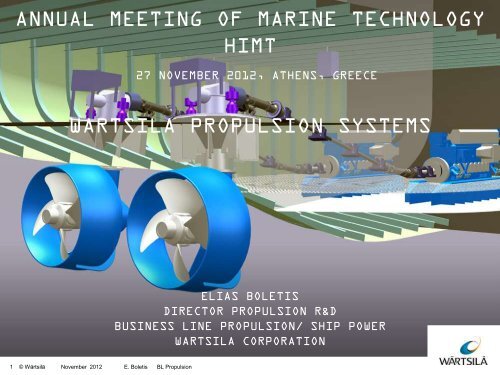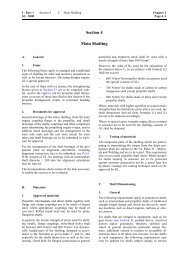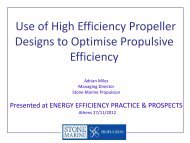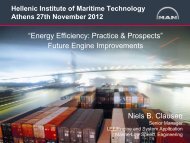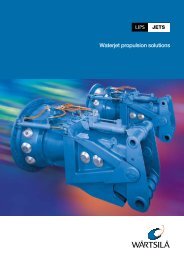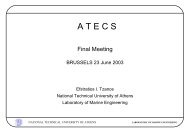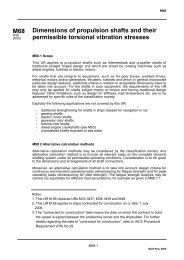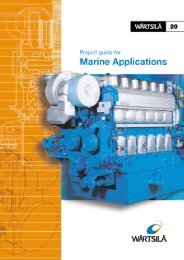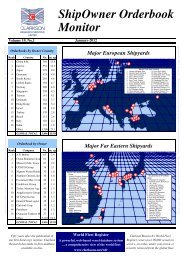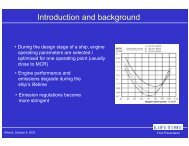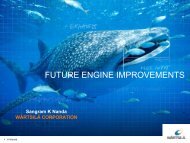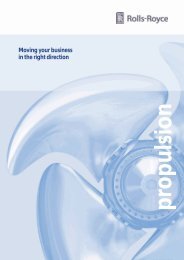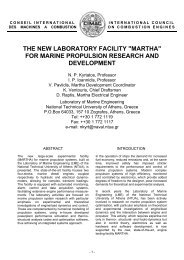annual meeting of marine technology himt wartsila propulsion systems
annual meeting of marine technology himt wartsila propulsion systems
annual meeting of marine technology himt wartsila propulsion systems
You also want an ePaper? Increase the reach of your titles
YUMPU automatically turns print PDFs into web optimized ePapers that Google loves.
ANNUAL MEETING OF MARINE TECHNOLOGY<br />
HIMT<br />
27 NOVEMBER 2012, ATHENS, GREECE<br />
WARTSILA PROPULSION SYSTEMS<br />
ELIAS BOLETIS<br />
DIRECTOR PROPULSION R&D<br />
BUSINESS LINE PROPULSION/ SHIP POWER<br />
WARTSILA CORPORATION<br />
1 © Wärtsilä<br />
November 2012 E. Boletis BL Propulsion
3 © Wärtsilä<br />
November 2012 E. Boletis BL PROPULSION
© Wärtsilä<br />
4 © Wärtsilä<br />
6 September 2012 E. Boletis BL PROPULSION
Wartsila: The only complete <strong>marine</strong> <strong>of</strong>fering<br />
Service<br />
agreements<br />
Ship design<br />
Communication<br />
and control<br />
Flow & gas<br />
solutions<br />
Propulsion<br />
+ DP +<br />
Manoeuvring<br />
Environmental<br />
solutions<br />
Automation<br />
Engines<br />
Seals &<br />
bearings<br />
Power<br />
distribution<br />
Power drives<br />
5
New Base Propulsion Products for Integrated Designs<br />
Marine<br />
Gear<br />
Boxes<br />
- Single stage reduction<br />
- Hybrid - two stage reduction<br />
- Two in - single out<br />
Propellers<br />
- All applications (FPP, CPP)<br />
- Heavy Duty<br />
- Ice capability<br />
- Customized as required<br />
- Efficiency enhancement<br />
Thrusters<br />
- Low Initial Cost<br />
- Optimized for ship designs<br />
- Ice class as required<br />
- Retractable or<br />
Under Water Demountable<br />
- Both Steerable and Tunnel<br />
8 © Wärtsilä November 2012 E. Boletis BL Propulsion
Re- newed Thruster Portfolio<br />
High efficiency Tunnel Thrusters<br />
Reliable, Under- water demountables<br />
Low cost, enhanced<br />
functionality Steerables
Constant versus variable speed operation<br />
< 5%<br />
For controllable pitch propellers, operation at<br />
a constant number <strong>of</strong> revolutions over a wide ship<br />
speed reduces efficiency. Reduction <strong>of</strong> the<br />
number <strong>of</strong> revolutions at reduced ship speed will<br />
give fuel savings.<br />
Saves 5% fuel, depending on actual<br />
operating conditions.<br />
10 © Wärtsilä
Optimisation <strong>of</strong> Propeller and hull interaction<br />
< 4%<br />
The propeller and the ship interact. The<br />
acceleration <strong>of</strong> water due to propeller action can<br />
have a negative effect on the resistance <strong>of</strong> the<br />
ship or appendages. This effect can today be<br />
predicted and analysed more accurately using<br />
computational techniques.<br />
Redesigning the hull, appendages and propeller<br />
together will at low cost improve performance by<br />
up to 4%.<br />
11 © Wärtsilä
Advanced propeller blade sections<br />
< 2%<br />
Advanced blade sections will improve the<br />
cavitation performance and frictional<br />
resistance <strong>of</strong> a propeller blade.<br />
As a result the propeller is more efficient.<br />
Improved propeller efficiency <strong>of</strong> up to 2%.<br />
12 © Wärtsilä
Advanced propeller blade designs<br />
Potential-flow based methods<br />
+ cavitation behaviour<br />
+ computation effort<br />
- performance<br />
- pr<strong>of</strong>ile drag prediction<br />
- flexibility in geometry<br />
Viscous CFD based methods<br />
+ performance (model & full scale)<br />
+ pr<strong>of</strong>ile drag prediction<br />
+/- flexibility in geometry handling<br />
- cavitation behaviour<br />
Next generation CFD methods<br />
(including time-dependent<br />
cavitation)<br />
+ performance (model & full scale)<br />
+ pr<strong>of</strong>ile drag<br />
+ flexible geometry handling<br />
+ cavitation behavior<br />
+ adjoint based pr<strong>of</strong>ile optimization<br />
- computation effort<br />
• New numerical analysis & design methods need to give proper<br />
prediction <strong>of</strong> pr<strong>of</strong>ile lift and drag and cavitation behavior<br />
• This requires viscous methods with implemented cavitation model<br />
• Implementation is planned in Virtual Validation Propulsion project<br />
3<br />
28 November 2012
Propeller tip winglets<br />
< 4%<br />
Winglets are known from the aircraft industry.<br />
The design <strong>of</strong> special tip shapes can now<br />
be based on computational fluid dynamic<br />
calculations which will improve propeller<br />
efficiency.<br />
Improved propeller efficiency <strong>of</strong> up to 4%.<br />
14 © Wärtsilä
Propeller nozzle<br />
< 5%<br />
Installing nozzles shaped like a<br />
wing section around a propeller<br />
will save fuel for ship speeds <strong>of</strong><br />
up to 20 knots.<br />
Up to 5% power savings<br />
compared to a vessel<br />
with an open propeller.<br />
15 © Wärtsilä
Propeller-rudder combinations<br />
< 4%<br />
The rudder has drag in the order <strong>of</strong> 5%<br />
<strong>of</strong> ship resistance. This can be reduced<br />
by 50% by changing the rudder pr<strong>of</strong>ile and<br />
the propeller. Designing these together with<br />
a rudder bulb will give additional benefits.<br />
This system is called the Energopac®<br />
system.<br />
Improved fuel efficiency <strong>of</strong> 2% to 6%.<br />
16 © Wärtsilä
CRP <strong>propulsion</strong><br />
< 12%<br />
Counter rotating propellers consist <strong>of</strong> a pair <strong>of</strong><br />
propellers behind each other that rotate in<br />
opposite directions. The aft propeller recovers<br />
some <strong>of</strong> the rotational energy in the slipstream<br />
from the forward propeller. The propeller couple<br />
also gives lower propeller loading than for a<br />
single propeller resulting in better efficiency.<br />
CRP propellers can either be mounted on twin<br />
coaxial counter rotating shafts or the aft propeller<br />
can be located on a steerable propulsor aft <strong>of</strong> a<br />
conventional shaft line.<br />
CRP has been documented as the propulsor<br />
with one <strong>of</strong> the highest efficiencies. The power<br />
reduction for a single screw vessel is 10% to 15%.<br />
17 © Wärtsilä
New Machinery Automation - Tomorrow<br />
Wärtsilä Bridge<br />
DP<br />
Dynamic<br />
Positioning<br />
JOY<br />
Joystick<br />
Redundant bus<br />
BCS<br />
Bridge Control System<br />
Tomorrow<br />
• One machinery automation<br />
platform – UNIC<br />
• One vessel/plant automation<br />
platform – PLC<br />
• Alignment with Wärtsilä Bridge<br />
• Alignment with Wärtsilä<br />
Optimizers<br />
Engine Control Room, ECR<br />
PPU<br />
Propulsion<br />
Performance Unit<br />
ECS<br />
Engine Control<br />
System<br />
New pic<br />
needed!<br />
IAS<br />
Alarm<br />
System<br />
PMS Power<br />
Management<br />
System<br />
Products & solutions<br />
Hierarchical levels<br />
Modular products<br />
Clear interfaces, roles &<br />
responsibilities<br />
Engine room<br />
Local control units<br />
ENGINE ROOM<br />
Gearbox, UNIC<br />
CPP control, UNIC<br />
HCU<br />
HCU<br />
Engine controls,<br />
UNIC<br />
Plantnet<br />
Wärtsilä<br />
Manufacturing agility<br />
Engineering agility<br />
Lifecycles ensured<br />
Customer<br />
TCO efficiency<br />
Solution agility<br />
Quality & sustainability<br />
19 © Wärtsilä 28 November 2012 Presentation name / Author
Transition from model tests to simulations<br />
model scale testing only<br />
thruster<br />
performance<br />
propeller<br />
performance<br />
<strong>propulsion</strong><br />
cavitation<br />
resistance<br />
numerical simulations only<br />
2000 2005 2010 2015 2020<br />
2<br />
28 November 2012
Concluding Remarks<br />
- Large percent <strong>of</strong> shipping cost<br />
is fuel (40% in many cases).<br />
- Fuel cost and environment are<br />
the main drivers<br />
- A significant Fuel Saving<br />
Potential exists.<br />
- Propulsive efficiency is a key<br />
issue.<br />
- We would need the combined<br />
Industry effort to take full<br />
advantage <strong>of</strong> such a Potential.<br />
24 © Wärtsilä<br />
November 2012 E. Boletis BL Propulsion
Symbol explanations<br />
< 4%<br />
An upper percentage for the potential <strong>annual</strong> saving<br />
in fuel consumption for the entire ship, not looking just<br />
at the saving in one mode for a specific part <strong>of</strong> the<br />
power demand.<br />
Energy consumption reduction<br />
method applicability:<br />
Methods best suited for new buildings<br />
Measures that can be retr<strong>of</strong>itted<br />
to an existing vessel<br />
Operational measures<br />
Payback time indication:<br />
Ship types for which the energy<br />
efficiency improvement measure<br />
is well suited.<br />
Short (15 years)<br />
25 © Wärtsilä


